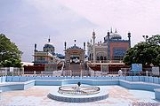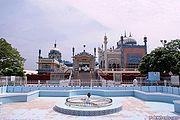
Bhong Mosque
Encyclopedia

Bhong
Bhong is a small but important town of Rahim Yar Khan District in the Punjab province of Pakistan. It is a Union Council of Sadiqabad tehsil and is located 200 kilometres away from Bhawalpur at 28° 25' 0" North, 69° 55' 0" East...
, Sadiqabad Tehsil
Sadiqabad Tehsil
Sadiqabad is a subdivision of Rahim Yar Khan District in the Punjab province of Pakistan. It is administratively subdivided into 29 Union Councils, six of which form the tehsil capital Sadiqabad....
, Rahim Yar Khan District, Southern Punjab Pakistan
Pakistan
Pakistan , officially the Islamic Republic of Pakistan is a sovereign state in South Asia. It has a coastline along the Arabian Sea and the Gulf of Oman in the south and is bordered by Afghanistan and Iran in the west, India in the east and China in the far northeast. In the north, Tajikistan...
. It was designed and constructed over a period of nearly 50 years (1932–1982) and won the Aga Khan Award for Architecture
Aga Khan Award for Architecture
The Aga Khan Award for Architecture is an architectural prize established by Aga Khan IV in 1977. It aims to identify and reward architectural concepts that successfully address the needs and aspirations of Islamic societies in the fields of contemporary design, social housing, community...
in 1986. A postage stamp depicting it was issued on May 12, 2004 in Pakistan.
Introduction
The mosque is located at the distance of 200 kilometers from Bahawalpur and 50 kilometers from Rahim Yar Khan and is well known for its exquisite design and architectural beauty with gold leaves carved for the intricate decorative patterns and the stylish calligraphic work.Sardar Rais Ghazi Mohammad Indhar, a wealthy landlord, commissioned this mosque in 1932 to be the jewel of his new palace compound, which already included a mosque and a prestigious Madrasa (religious school) and was completed in 1982.
Sardar Rais Ghazi Mohammad Indhar, client, designer, patron and landlord conceived, directed and funded the entire building construction. The construction of mosque was carried out by specialists gathered from all over Pakistan and India: master masons from Rajisthan, India; craftsmen from Multan for the glazed tile, mosaic and woodwork; and painters and calligraphers from Karachi. Workshops were set up to train craftsmen in skills that had originally been passed from father to son. Materials and crafts used range from the traditional - teak, ivory, marble, colored glass, onyx, glazed tile, fresco, mirrors, gilded tracery, ceramics, calligraphy and inlay - to the modern and synthetic marbled industrial tile, artificial stone facing, terrazzo, colored cement tile and wrought iron. Sardar Rais Ghazi's intention was to represent as many forms of popular craft and as many Islamic religious architectural features as possible.
Over the 50 years of its evolution, the Bhong Mosque Complex has generated jobs and trained approximately 1000 workers and craft men in indigenous crafts. Its construction laid an edifice for socio-economic development and provision of basic amenities of life including market roads, schools, electricity, gas, bank, hospital, post office etc. to the local population.
Infrastructure
The construction of the mosque was carried out by specialists gathered from all over PakistanPakistan
Pakistan , officially the Islamic Republic of Pakistan is a sovereign state in South Asia. It has a coastline along the Arabian Sea and the Gulf of Oman in the south and is bordered by Afghanistan and Iran in the west, India in the east and China in the far northeast. In the north, Tajikistan...
and India
India
India , officially the Republic of India , is a country in South Asia. It is the seventh-largest country by geographical area, the second-most populous country with over 1.2 billion people, and the most populous democracy in the world...
: master masons from Rajasthan
Rajasthan
Rājasthān the land of Rajasthanis, , is the largest state of the Republic of India by area. It is located in the northwest of India. It encompasses most of the area of the large, inhospitable Great Indian Desert , which has an edge paralleling the Sutlej-Indus river valley along its border with...
, India, craftsmen from Multan
Multan
Multan , is a city in the Punjab Province of Pakistan and capital of Multan District. It is located in the southern part of the province on the east bank of the Chenab River, more or less in the geographic centre of the country and about from Islamabad, from Lahore and from Karachi...
for the glazed tile, mosaic and woodwork, and painters and calligraphers from Karachi
Karachi
Karachi is the largest city, main seaport and the main financial centre of Pakistan, as well as the capital of the province of Sindh. The city has an estimated population of 13 to 15 million, while the total metropolitan area has a population of over 18 million...
. Workshops were set up to train craftsmen in skills that had originally been passed from father to son. The mosque's design is a mix of Islamic styles, using rare and traditional materials such as ivory, teak, and onyx, along with industrial elements like terrazzo and artificial stone facing. Broadly eclectic in their use of sources, the builders borrowed stylistic elements from nearby Lahore, as well as Iran, Spain and Turkey, and combined them with Western colonial elements of the 1940s.
Benefactor
The mosqueMosque
A mosque is a place of worship for followers of Islam. The word is likely to have entered the English language through French , from Portuguese , from Spanish , and from Berber , ultimately originating in — . The Arabic word masjid literally means a place of prostration...
was commissioned in 1932 by Rais Ghazi Mohammad,to be the jewel of his new palace compound where another mosque and prestigious religious school already stood. Rais Ghazi Mohammad was given the highest civilian award of Pakistan from the government namely "Sitara-e-Imtiaz" on March 23, 2004 in recognition of his services.
Award
Aga Khan Award for Architecture 1986.In recognition of his significant sole attempt to create a local Islamic Center of learning and building crafts, Sardar Rais Ghazi Mohammad was awarded the Aga Khan Award for Architecture
Aga Khan Award for Architecture
The Aga Khan Award for Architecture is an architectural prize established by Aga Khan IV in 1977. It aims to identify and reward architectural concepts that successfully address the needs and aspirations of Islamic societies in the fields of contemporary design, social housing, community...
by His Highness Prince Karim Aga Khan in 1986 at Morocco. In the words of the Jury "Bhong enshrines and epitomizes the popular taste in Pakistan with all its vigor, pride, tension and sentiment. Its use, and misuse of signs and symbols expresses appropriate growing pains of an architecture in transition." The President, Islamic Republic of Pakistan has posthumously conferred upon Sardar Rais Ghazi Muhammad, "SITARA-I-IMTIAZ" on March 23, 2004 on Pakistan Day for his outstanding contribution to the field of Public Service (Bhong Mosque Architecture).
Critics, mostly Western, have called it "Arabian Nights a la Hollywood," noting how much it delights the Pakistani, yet bemoaning the fact that such a work will now set an architectural standard. To date, it has been the most controversial of the Aga Khan Architecture award winners.
See also
- Aga Khan Award for ArchitectureAga Khan Award for ArchitectureThe Aga Khan Award for Architecture is an architectural prize established by Aga Khan IV in 1977. It aims to identify and reward architectural concepts that successfully address the needs and aspirations of Islamic societies in the fields of contemporary design, social housing, community...
- Islam in PakistanIslam in PakistanIslam is the official religion of the Islamic Republic of Pakistan, which has a population of about 174,578,558. The overwhelming majority of the Pakistani people are Muslims while the remaining 3-5% are Christian, Hindu, and others. Pakistan has the second largest Muslim population in the world...
- Religious architectureReligious architectureSacred architecture is a religious architectural practice concerned with the design and construction of places of worship and/or sacred or intentional space, such as churches, mosques, stupas, synagogues, and temples...
External links
- Bhong Mosque, Rahim Yar Khan, Pakistan
- Aga Khan Award for Architecture - Third Award Cycle, 1984-1986
- Al ghazi trust hospital
- Pictures - Bhong Mosque
- Picture of Bhong Mosque.
Mosques in Pakistan

